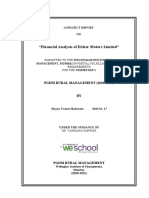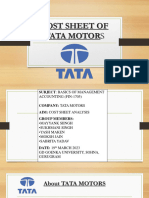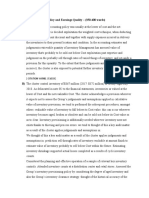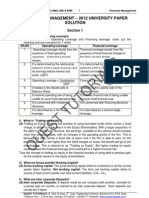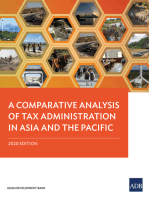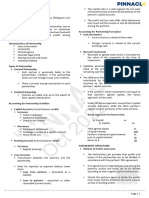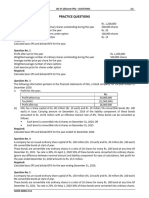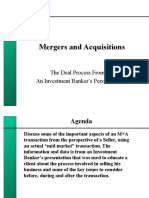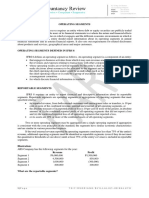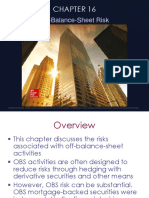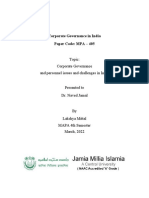Corporate Finance: Project Report
Corporate Finance: Project Report
Uploaded by
Neha ShawCopyright:
Available Formats
Corporate Finance: Project Report
Corporate Finance: Project Report
Uploaded by
Neha ShawOriginal Title
Copyright
Available Formats
Share this document
Did you find this document useful?
Is this content inappropriate?
Copyright:
Available Formats
Corporate Finance: Project Report
Corporate Finance: Project Report
Uploaded by
Neha ShawCopyright:
Available Formats
CORPORATE FINANCE
PROJECT REPORT
TOPIC-: COMPARATIVE ANALYSIS ON THE BASES OF CONCEPTS OF CORPORATE FINANCE ( COST OF CAPITAL OF DEBT, COST OF CAPITAL OF EQUITY, WACC, CAPITAL STRUCTURE , DIVIDEND POLICY AND CORPORATE GOVERNANCE)
SUBMITTED TO-: MS. SANDHYA PRAKASH
SUBMITTED BY-: ANUJA SAXENA PGP-20101046 Email id: anuja.saxena.pgp12@iilm.edu
Contents 1.Introduction 2.Corporate governance 3.Cost of capital of debt 4.Cost of capita of equity 5.WACC 6.Capital structure 7.Dividend policy
INTRODUCTION: To perform the comparative analysis, we have taken two companies of the same industry. We have taken TATA MOTORS and Mahindra and Mahindra. The factual figures have been taken from the annual report of both the companies of the year 2010-2011.
CORPORATE GOVERNANCE-:
MAHINDRA AND MAHINDRA They believe that good corporate governance is the foundation for shareholder returns, operational performance, attracting employees, clients, and partners, and creating a positive impact on the lives and businesses they touch. Their commitment to corporate governance has earned them a Level 1 rating for Governance and Value Creation from CRISIL, India's leading ratings, research, risk and policy advisory company, for three years running. Their Board of Directors provide the leadership that helps Mahindra & Mahindra contribute positively to the stakeholders prosperity, from shareholders to employees to customers to community members. Bringing together extensive experience and achievement across many industries, the Board of Directors helps guide Mahindra & Mahindra with a broad and deep collective wisdom.
TATA MOTORS As part of the Tata group, the Companys philosophy on Corporate Governance is founded upon a rich legacy of fair, ethical and transparent governance practices, many of which were in place even before they were mandated by adopting highest standards of professionalism, honesty, integrity and ethical behaviour. As a global organisation the Corporate Governance practices followed by the Company and its subsidiaries are compatible with international standards and best practices. Through the Governance mechanism in the Company, the Board along with its Committees undertake its duciary responsibilities to all its stakeholders by ensuring transparency, fairly and independence in its decision making. The Corporate Governance philosophy has been further strengthened with the implementation, a few years ago, by the Company of the Tata Business Excellence Model as a means to drive excellence, the Balanced Scorecard methodology for tracking progress on long term strategic objectives and the Tata Code of Conduct which articulates the values, ethics and business principles and serves as a guide to the Company, its directors and employees and an appropriate mechanism to report any concern pertaining to non-adherence to the said Code and addressing the same is also in place. The Company is in full compliance with the requirements of Corporate Governance under Clause 49 of the Listing Agreement with the Indian Stock Exchanges (the Listing Agreement). The Companys Depositary Programme is listed on the New York Stock Exchange and the Company also complies with
US regulations as applicable to Foreign Private Issuers (non-US listed companies) which cast upon the Board of Directors and the Audit Committee, onerous responsibilities to improve the Companys operating efficiencies. Risk management and internal control functions have been geared up to meet the progressive governance standards. As a good corporate governance practice, the Company has voluntarily undertaken an Audit by M/s Parikh & Associates, Practicing Company Secretaries, of the secretarial records and documents for the period under review in respect of compliance with the Companies Act, 1956, listing agreement with the Indian stock exchanges and the applicable regulations and guidelines issued by Securities and Exchange Board of India.
COST OF CAPITAL OF DEBT-: Cost of debt= (interest/debt)*100 For TATA motors-Interest= 1143.99 Debt= 15898.75 Cost of debt= (1143.99/15898.75)*100 = 7.2 For Mahindra and Mahindra Interest= 70.86 Debt= 2405.29 Cost of debt= (70.86/2405.29)*100 = 2.95 COMPARITIVE ANALYSIS: As we can see that the cost of debt of Tata motors is much higher than the Mahindra and Mahindra. And the loan amount of Tata motors is much higher than the Mahindra and Mahindra. So we can see that Tata motors is paying a big amount as interest to its creditors and that also on high interest rate comparatively. COST OF EQUITY-: Cost of equity= [D/P] +G Where D= dividend paid P= price of book value of share G= growth rate
Now, Growth Rate= retention ratio* return on equity And Retention ratio on equity = (PAT-preference dividend)/equity share holder fund And Equity share holder fund= equity capital+reserves and surplus-P+L (if debt balance)
For TATA motors Interest= 1143.99 Debt= 15898.75 Equity= 20009 PAT= 1811.82 Retention= 25.12 Dividend= 20 Book value= 315 a) Retention ratio on equity= (1811.82-0)/20009 = 0.091 b) Growth rate= .2512*.091= .023 c) Cost of equity= (20/315)+.023 =.0865*100=8.65 For Mahindra and Mahindra Interest= 70.86 Debt= 2405.29 Equity= 10279.42 PAT= 2662.10 Retention= 69.0 Dividend= 11.50 Book value= 175. 04 a) Retention on equity= (2662.10-0)/10279.42= .2589
b) Growth rate= 0.69*0.2589= 0. 178641 c) Cost of equity= (11.5/175.04)+ 0.178641= 0.2443*100= 24.43 COMPARITIVE ANALYSIS: as we can see that cost of equity of Mahindra and Mahindra is much higher than cost of equity of TaTa motors it is because m&m is retaining a big amount if money as reserves due to that growth rate is high and also price of M&M share is much less than TATA motors and they pay dividend more as percentage of share capital.
Cost of debt equity TATA motors Mahindra and Mahindra
cost of
7.2 2.95
8.65 24.43
This shows that TATA motors are paying more interest than Mahindra and Mahindra.
WACC (weighted average cost of capital)-: The weighted average cost of capital is the rate that a company is expected to pay on average to all its security holders to finance its assets. Hence it is the minimum return that a company must earn on an existing asset base to satisfy its creditors and investors. WACC= [(total equity/(total equity+ total debt))*cost of equity]+ [(total debt/( total equity+ total debt))*cost of equity]
WACC for TATA motors--Cost of equity (%)= 8.65 Total equity= 634.65 Cost of debt= 7.2 Total debt= 15898.75 Corporate tax= 30% WACC= 5.18
WACC for Mahindra and Mahindra---
Cost of equity (%) = 24.43 Total equity= 10279.42 Cost of debt= 2.95 Total debt= 2405.29 Corporate tax= 30% WACC= 20.19 COMARITIVE ANALYSIS WACC of Mahindra and Mahindra is far more than TATA motors which indicates a decrease in the valuation of the firm and comparatively a higher risk. WACC is high of M&M is high because their cost of equity is very high.
CAPITAL STRUCTURE-: A companys proportion of short of long term debt is considered while analyzing capital structure. When people refer to capital structure they are most likely referring to a firms debt to equity ratio which provides insight into how a company is usually a company more heavily financed by debt posing greater risk, as the firm is relatively highly levered. So here we show debt to equity ratio of---
0.8 0.7 0.6 0.5 0.4 0.3 0.2 0.1 0 debt equity TATA M&M
TATA motors---
Debt= 15898.75 Equity= 20009 Debt to equity ratio= 15898.75/ 20009= .79
Mahindra and Mahindra--Debt= 2405.29 Equity= 1027.42 Debt to equity ratio= 2405.29/1027.42= .23 COMPARITIVE ANALYSIS: the ideal debt to equity ratio is 2:1. Here as we can see that in both the companys debt is less as in percentage of equity. But if we compare these two TATA motors is more levered.
DIVIDEND POLICY-: For TATA motors-Dividend per share= 20% Earnings per share= 28.55 Dividend payout ratio= ( 20/28.55)*100 = 70% (for year 2010-11) year 2006-07 2007-08 2008-09 2009-10 2010-11 Dividend per share 15.00 15.00 12.50 15.00 20.00 Earnings per share 49.65 52.63 19.48 39.26 28.55 Dividend payout ratio (%) 30.21 28.15 64.16 38.20 70.00
For Mahindra and Mahindra--Dividend per share= 31% Earnings per share= 45.33 Dividend payout ratio= (11/45.33)* 100= 30.15% (for the year 2010-11) year Dividend per share Earnings per share Dividend payout
2006-07 2007-08 2008-09 2009-10 2010-11
11.50 11.50 10.00 9.50 11.50
44.88 46.15 30.69 36.89 45.33
ratio (%) 30.39 29.10 37.29 29.87 30.15
COMPARITIVE ANALYSIS: both the companies are paying the same amount of dividend with or with very less variation. In TATA motors they are paying between 12 to 20 per share and in M&M it is 9.50 to 11.50.
35 30 25 20 Dividend per share 15 10 5 0 2006-07 2007-08 2008-09 2009-10 2010-11 Dividend per share
REFERENCES
1. Annual report Tata motors (2010-11) 2. Annual report Mahindra and Mahindra (2010-11) 3. Money control.com
You might also like
- UNIT 1-Written Assignment-BUS 5110Document5 pagesUNIT 1-Written Assignment-BUS 5110Aliyazahra Kamila100% (1)
- Financial Management SystemDocument10 pagesFinancial Management SystemshinoharaxayumiNo ratings yet
- Compensation Management TATA Motors 2Document86 pagesCompensation Management TATA Motors 2deepak Gupta75% (4)
- NVRDocument125 pagesNVRJohn Aldridge Chew100% (1)
- Sandip Voltas ReportDocument43 pagesSandip Voltas ReportsandipNo ratings yet
- Ratio ANALYSIS OF CEAT TYRESDocument37 pagesRatio ANALYSIS OF CEAT TYRESS92_neha100% (1)
- Syndicate 7 - Nike Inc. Cost of CapitalDocument8 pagesSyndicate 7 - Nike Inc. Cost of CapitalAnthony Kwo100% (1)
- Chapter 15 Company AnalysisDocument51 pagesChapter 15 Company Analysissharktale282850% (2)
- Report On Eicher MotorsDocument49 pagesReport On Eicher MotorsMayur Hadawale100% (1)
- Tugas ALK Chapter 7Document8 pagesTugas ALK Chapter 7Alief AmbyaNo ratings yet
- A Project Report On Ratio AnalysisDocument34 pagesA Project Report On Ratio AnalysisSoni Bajpai100% (1)
- Cost and Management Accounting End Term AssignmentDocument13 pagesCost and Management Accounting End Term Assignmentzj9k85pc4mNo ratings yet
- Costsheetoftatamotors 230506154745 Eceed448Document14 pagesCostsheetoftatamotors 230506154745 Eceed4482526avnishNo ratings yet
- Investment Upload EngDocument10 pagesInvestment Upload EngMinh Trí CaoNo ratings yet
- Name and Address of CompanyDocument19 pagesName and Address of Companydenny7777777No ratings yet
- Aditya Birla Draft 1Document5 pagesAditya Birla Draft 1Vishruth KhareNo ratings yet
- Finance CA 1Document12 pagesFinance CA 1Pandey Avinash RavindrakumarNo ratings yet
- Name and Address of CompanyDocument19 pagesName and Address of CompanyDinesh AilaniNo ratings yet
- FM Ceat CompanyDocument13 pagesFM Ceat CompanyManu K AnujanNo ratings yet
- FM Project End TermDocument5 pagesFM Project End TermManisha SatpathyNo ratings yet
- Chap 8 - Advanced Issues in ValuationDocument50 pagesChap 8 - Advanced Issues in Valuationrafat.jalladNo ratings yet
- CapstruDocument34 pagesCapstruKrupa ShahNo ratings yet
- Financial Management AssignmentDocument16 pagesFinancial Management AssignmentNishant goyalNo ratings yet
- Profitability Position of Aditya BirlaDocument10 pagesProfitability Position of Aditya BirlaPalmodiNo ratings yet
- Corporate Finance Report AnalysisDocument64 pagesCorporate Finance Report AnalysisabhdonNo ratings yet
- VebitdaDocument24 pagesVebitdaAndr EiNo ratings yet
- Cd-33-A STUDY ON COST ANALYSIS & CONTROL PDFDocument93 pagesCd-33-A STUDY ON COST ANALYSIS & CONTROL PDFprabhakar76100% (1)
- FINANCIAL STATEMENT ANALYSIS (Assignment 1)Document21 pagesFINANCIAL STATEMENT ANALYSIS (Assignment 1)Syafiqah AmranNo ratings yet
- Salalah Mills Performance 1Document15 pagesSalalah Mills Performance 1پاکیزہ مسکانNo ratings yet
- Understanding Financial StatementsDocument36 pagesUnderstanding Financial StatementsDurga PrasadNo ratings yet
- Nike INCDocument7 pagesNike INCUpendra Ks50% (2)
- Project Financial Accounting For Managers PGDM 2013-2015Document11 pagesProject Financial Accounting For Managers PGDM 2013-2015minalgargNo ratings yet
- Financial Cost Analysis Assignment - Devashree Thanekar - 17041823099Document10 pagesFinancial Cost Analysis Assignment - Devashree Thanekar - 17041823099devashree.tNo ratings yet
- Accounting - Cabcharge - 8 AugustDocument8 pagesAccounting - Cabcharge - 8 AugustAijaz ShaikhNo ratings yet
- Working Capital Management of EscortDocument74 pagesWorking Capital Management of EscortKavita NadarNo ratings yet
- Voltamp Transformers Ltd. Was Initially Incorporated As Private Limited Company and Established in Year 1967 in Vadodara. Further, by SpecialDocument8 pagesVoltamp Transformers Ltd. Was Initially Incorporated As Private Limited Company and Established in Year 1967 in Vadodara. Further, by Specialreet gillNo ratings yet
- Anamika Chakrabarty Anika Thakur Avpsa Dash Babli Kumari Gala MonikaDocument24 pagesAnamika Chakrabarty Anika Thakur Avpsa Dash Babli Kumari Gala MonikaAnamika ChakrabartyNo ratings yet
- Assignment 1 (Financial Ratio Analysis)Document22 pagesAssignment 1 (Financial Ratio Analysis)Syafiqah AmranNo ratings yet
- Liquidity and Profitability RatioDocument5 pagesLiquidity and Profitability RatioRituraj RanjanNo ratings yet
- Ratio Analysis of APLDocument15 pagesRatio Analysis of APLTusarkant BeheraNo ratings yet
- Module 6 - Corporate ValuationDocument7 pagesModule 6 - Corporate ValuationushaNo ratings yet
- Profitability Ratios: Profit MarginDocument6 pagesProfitability Ratios: Profit Marginimdad1986No ratings yet
- Cap Struc TheoriesjDocument19 pagesCap Struc TheoriesjPratik AhluwaliaNo ratings yet
- Working Capital ManagementDocument49 pagesWorking Capital ManagementAshok Kumar KNo ratings yet
- Introduction Business Account and FinanceDocument45 pagesIntroduction Business Account and FinanceLuthfi Bin LokmanNo ratings yet
- Ashok Ley LandDocument105 pagesAshok Ley LandAmit NagarNo ratings yet
- Business Valuation of WiproDocument13 pagesBusiness Valuation of Wiprohardik08patelNo ratings yet
- Part A: Accounting Policy and Earnings Quality - (350-400 Words) A) in Inventories The Accounting Policy Was Usually at The Lower of Cost and The NetDocument7 pagesPart A: Accounting Policy and Earnings Quality - (350-400 Words) A) in Inventories The Accounting Policy Was Usually at The Lower of Cost and The NetSamurdhiNo ratings yet
- AccountsDocument21 pagesAccountsfc2fy4gdgwNo ratings yet
- The Value of Control: Stern School of BusinessDocument38 pagesThe Value of Control: Stern School of Businessavinashtiwari201745No ratings yet
- Bms - Financial Management Solution - 2012Document12 pagesBms - Financial Management Solution - 2012QuestTutorials BmsNo ratings yet
- Summer Training ReportDocument21 pagesSummer Training ReportVipul YadavNo ratings yet
- Financial Analysis of Mahindra and MahindraDocument25 pagesFinancial Analysis of Mahindra and Mahindranamit_agarwal12No ratings yet
- P 7Document47 pagesP 7billyryan1No ratings yet
- ASEAN Corporate Governance Scorecard Country Reports and Assessments 2015: Joint Initiative of the ASEAN Capital Markets Forum and the Asian Development BankFrom EverandASEAN Corporate Governance Scorecard Country Reports and Assessments 2015: Joint Initiative of the ASEAN Capital Markets Forum and the Asian Development BankNo ratings yet
- A Comparative Analysis of Tax Administration in Asia and the Pacific: 2020 EditionFrom EverandA Comparative Analysis of Tax Administration in Asia and the Pacific: 2020 EditionNo ratings yet
- Wiley CMAexcel Learning System Exam Review 2017: Part 2, Financial Decision Making (1-year access)From EverandWiley CMAexcel Learning System Exam Review 2017: Part 2, Financial Decision Making (1-year access)No ratings yet
- A Comparative Analysis of Tax Administration in Asia and the Pacific: 2018 EditionFrom EverandA Comparative Analysis of Tax Administration in Asia and the Pacific: 2018 EditionNo ratings yet
- The Balanced Scorecard: Turn your data into a roadmap to successFrom EverandThe Balanced Scorecard: Turn your data into a roadmap to successRating: 3.5 out of 5 stars3.5/5 (4)
- A Study of the Supply Chain and Financial Parameters of a Small BusinessFrom EverandA Study of the Supply Chain and Financial Parameters of a Small BusinessNo ratings yet
- A Comparative Analysis of Tax Administration in Asia and the Pacific: 2016 EditionFrom EverandA Comparative Analysis of Tax Administration in Asia and the Pacific: 2016 EditionNo ratings yet
- PartnershipDocument20 pagesPartnershipYudna YuNo ratings yet
- IAS 33 (Diluted EPS) - Class Practice (Questions)Document2 pagesIAS 33 (Diluted EPS) - Class Practice (Questions)sarim.shareefNo ratings yet
- Application Summary FormDocument2 pagesApplication Summary FormActions AvonNo ratings yet
- Pam Corporation Paid $170,000 For An 80 Percent Interest in Sun CorporationDocument3 pagesPam Corporation Paid $170,000 For An 80 Percent Interest in Sun CorporationJalaj GuptaNo ratings yet
- The Legal Framework of The Philippine Banking System: Atty. Elmore O. CapuleDocument114 pagesThe Legal Framework of The Philippine Banking System: Atty. Elmore O. CapuleMakoy BixenmanNo ratings yet
- Corp. Law Outline 3 (2020)Document3 pagesCorp. Law Outline 3 (2020)Effy SantosNo ratings yet
- Case 3 - Exercise 1 The Lakeside Company Analytical Review Procedures December 31, 2012Document4 pagesCase 3 - Exercise 1 The Lakeside Company Analytical Review Procedures December 31, 2012janeeta mathew100% (2)
- 1 Cost Concept and Cost BehaviourDocument176 pages1 Cost Concept and Cost BehaviourCristine Joy J. BenitezNo ratings yet
- MAS 2 - Optimal Capital StructureDocument5 pagesMAS 2 - Optimal Capital StructureNathallie CabalunaNo ratings yet
- 7020-Commerce-And-Finance SCHEME OF WORKDocument11 pages7020-Commerce-And-Finance SCHEME OF WORKCyrus PatemNo ratings yet
- PDF Financial Accounting For Management An Analytical Perspective 5Th Edition Ambrish Gupta Ebook Full ChapterDocument53 pagesPDF Financial Accounting For Management An Analytical Perspective 5Th Edition Ambrish Gupta Ebook Full Chapterjessie.ham964100% (3)
- Mergers and Acquisitions: The Deal Process From An Investment Banker's PerspectiveDocument35 pagesMergers and Acquisitions: The Deal Process From An Investment Banker's Perspectiverachana.bang3967No ratings yet
- Singapore Legislation Guide: by Liew Lan Hing and Gerald Heng Baker & Mckenzie - Wong & LeowDocument39 pagesSingapore Legislation Guide: by Liew Lan Hing and Gerald Heng Baker & Mckenzie - Wong & LeowJg AkNo ratings yet
- FAR04 01.5 Operating SegmentDocument5 pagesFAR04 01.5 Operating Segmentnicole bancoroNo ratings yet
- b.comDocument17 pagesb.comBRAINSTORM Haroon RasheedNo ratings yet
- SaundersChap016 FinalDocument24 pagesSaundersChap016 FinalPrincess AdaleaNo ratings yet
- InstructionalManualEnglish PDFDocument17 pagesInstructionalManualEnglish PDFMuhammad SalmanNo ratings yet
- Chapter 7 Part 2Document23 pagesChapter 7 Part 2meahangela.labadan.23No ratings yet
- Trial Balance-ROEMY BAKERYDocument2 pagesTrial Balance-ROEMY BAKERYNurqomariyahNo ratings yet
- Corporate Governance in IndiaDocument14 pagesCorporate Governance in IndiaZoya KhanNo ratings yet
- Convertible BondDocument8 pagesConvertible BonddewratNo ratings yet
- Analisis Laporan Keuangan Pada PT Impack Pratama Industri TBKDocument24 pagesAnalisis Laporan Keuangan Pada PT Impack Pratama Industri TBKzul zilaNo ratings yet
- CH 4 AnnaDocument8 pagesCH 4 Annamatt.yu666No ratings yet
- FAST - Annual Report - 2018 PDFDocument274 pagesFAST - Annual Report - 2018 PDF「絆笑」Hodae0% (1)
- Accounting Principles, 9th Edition OUTLINESDocument7 pagesAccounting Principles, 9th Edition OUTLINESAsghar AliNo ratings yet
- Acc407 Quiz 1 Introduction To Accounting (Question)Document7 pagesAcc407 Quiz 1 Introduction To Accounting (Question)Tuan Ainnur100% (1)
- Accounting Concepts and Principles GRADE11 FUNDA1Document30 pagesAccounting Concepts and Principles GRADE11 FUNDA1Jhana Mae BandosaNo ratings yet









